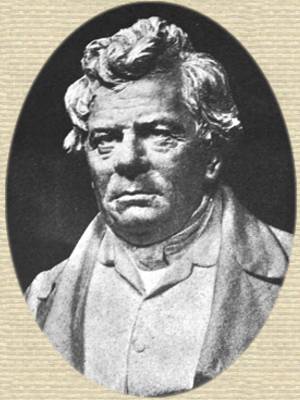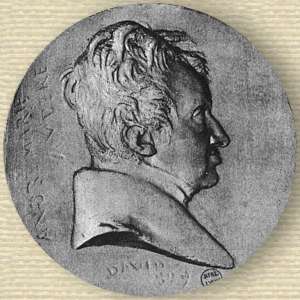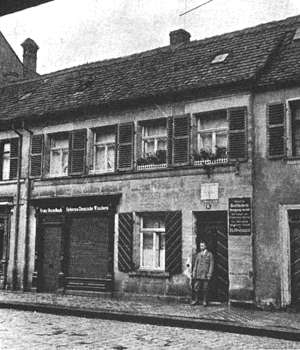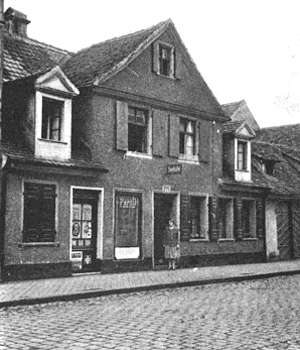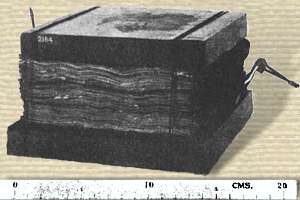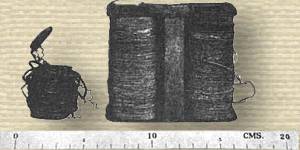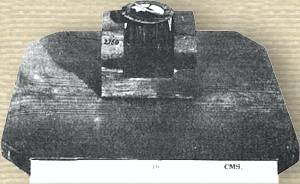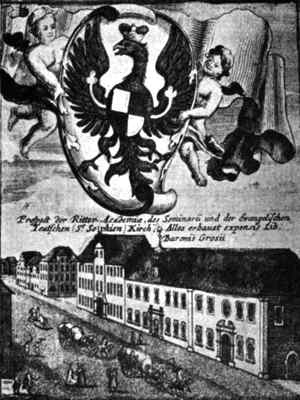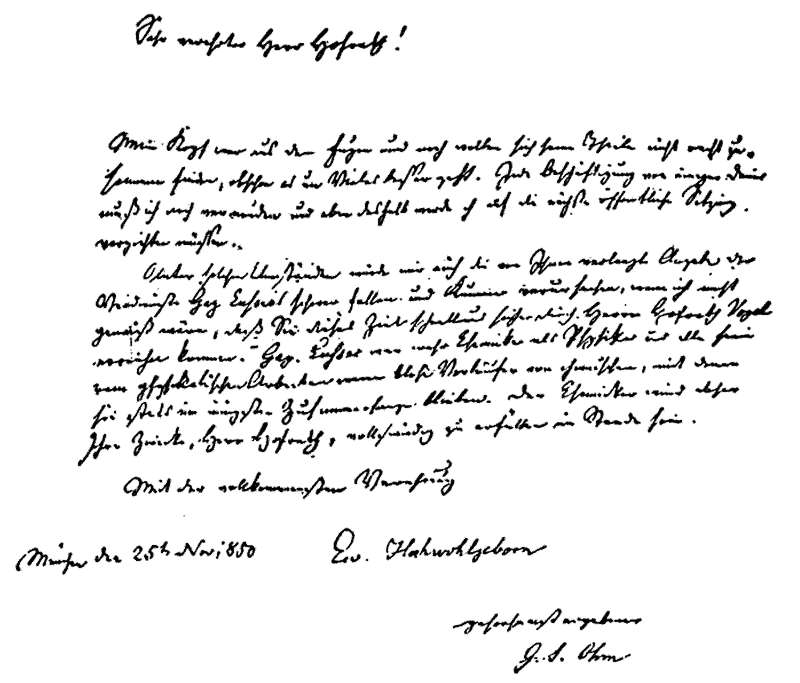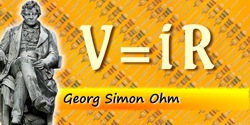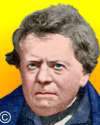 (source)
(source)
|
Georg Simon Ohm
(16 Mar 1789 - 6 Jul 1854)
German physicist who is known for his statement of his famous Ohm’s Law: V=iR. This relates current flowing through the resistance of a conductor and the potential difference (voltage) across it, at constant temperature.
|
GEORG SIMON OHM
from Pioneers of Electrical Communication (1930)
by Rollo Appleyard
[p.179] A Century ago, the science and practice of electrical measurement and the principles of design for electrical instruments scarcely existed. With a few exceptions, ill-defined expressions relating to quantity and intensity, combined with immature ideas of conductivity and derived circuits, retarded the progress of quantitative electrical investigations. Yet, amidst this confusion, a discovery had been made that was destined to create order out of chaos, to convert electrical measurement into the most precise of all physical operations, and to aid almost every other branch of quantitative research. This discovery resulted from the arduous labours of Georg Simon Ohm.
So completely has his work now merged into general knowledge, that his life is lost sight of in a law, and his name in a unit. Writings, all too brief, of his friends Bauernfeind and Mann enable some of the scattered details of his personal history to be ascertained. Relics of his laboratory apparatus, few as they are, give hints of the circumstances in which he carried out his researches. Fortunately, however, in contrast with the broken narrative that tells of his career, there exist his published scientific memoirs, collected with such care and comprehension by Eugene Lommel. that Ohm’s achievements are established more firmly than they might have been if every detail of the sombre history of his honourable life had run the gauntlet of the cyclopaedias. To these memoirs must be added the volume of reprints of certain of his letters and other documents which, thanks to the industry and zeal of Ludwig Hartmann of Munich, were collected and printed as a tribute to [p.180] Ohm on the occasion, in 1927, of the centenary of the publication of the immortal treatise on the electric circuit.
Ohm belonged to a German burgher family, from father to son, locksmiths. His great grandfather was Wilhelm Ohm, of Westerholt, near Minister, in Westphalia. His grandfather was Johann Vincentius Ohm, a journeyman locksmith, who settled first at Cadolzburg; there he married, but in 1764 he made his home in the university town of Erlangen, Bavaria, where he obtained citizen rights. Johann Vincentius had two sons. The elder, Johann Wolfgang, born in 1752, was apprenticed as a locksmith in 1776, and after ten years of wandering as a journeyman he returned to Erlangen, where, in 1785, he became a master locksmith. On January 24, 1786, this Johann Wolfgang Ohm married Fraulein Beck, or Beckin, the daughter of a tailor. They had seven children. The first child of this marriage was Georg Simon Ohm, who, according to the most trustworthy authorities, was born on March 16, 1789. A second son, Martin (junior) was born in 1792. In the late summer of 1799, when Georg was but ten years old, their mother died. Of the children, only three grew up; these were Georg Simon, Martin (junior), and Elizabeth Barbara. Martin (junior), it must suffice here to observe, became a distinguished mathematician, and a Professor of Mathematics at the Military College. Berlin.
The younger son of Johann Vincentius Ohm was Martin (senior), born in 1763, i.e. a year before the settlement of Johann Vincentius in Erlangen. This Martin (senior) similarly became a locksmith in Erlangen; he married on February 23, 1789, at the Neustadter Church at Erlangen, Elizabeth Sabina Krug, the daughter of a peasant from the Uehlfeld district. They had five children, none of whom survived infancy. The death of his wife soon followed. On June 23, 1800, he married Sabina Katherina Frasz, a hosier’s daughter, and on February 16, 1801, a daughter was born. Martin (senior) Ohm survived the birth of this daughter only a few weeks. He died on April 5, 1801, at the age of thirty-seven years, seven months, and twenty-three days. He was godfather to his nephew Martin (junior), the son of Johann Wolfgang Ohm.
[p.181] These details help to dispel doubts concerning the birthplace and the dates appertaining to Georg. It is remarkable that the records of one who devoted his whole life to precision should call for so much hesitancy in acceptance, but the tablet upon the house where he is alleged to have been born, and the inscription upon his tombstone, are discordant with his history. Moreover, he could scarcely call his name his own. The date and place of birth have recently been investigated, by Dr. Deuerlein of Erlangen. His account of the matter was published in a supplement to the Erlanger Neueste Nachrichten of June 25,1927. He found, in the Register of the Evangelical Lutheran Church of Erlangen, Neustadt, the entry of baptism:
1789 Martius den 18 t. (wurde getauft) Johann Simon, Mstrs. Johann Wolfgang Ohms, Bürgers und Schlossers dahier, und seiner Ehefrau Maria Elisabetha geb. Beckin von hier. Söhnl. geb. den 16. Abends um 3 Uhr. Gev. war Mstr. Johann Simon Beck, Bürger und Schneider dahier, der Kindbetterin Bruder.
[1789 March 18th (was christened) Johann Simon—son of Johann Wolfgang Ohm—citizen and locksmith of this district— and of his wedded wife Maria Elizabetha, formerly Beckin of this district. The child was born on the 16th at 3 o’clock in the afternoon. Godfather was Mr. Johann Simon Beck, citizen and tailor of this district, brother of the child’s mother].
This leaves no doubt that the date of birth was March 16, 1789, and that the boy was christened Johann Simon. The name by which he was subsequently known was Georg Simon— possibly to avoid its being mistaken in the family for that of his father, Johann.
The house in Erlangen upon which the memorial tablet is placed is No. 6 Fahrstrasse (Fig. 1). From the town records it is known that this house was built in 1733. Its first occupant was the builder of it, Joh. Gg. Held, who sold it to the hatter, Leonard Hofmann. From October, 1754 it was owned by the tobacconist, Andreas Wolckel. He died and left a widow who on March 1, 1779, transferred it to Elias Reinhard, a hosier, from whom it passed by inheritance on June 18, 1782, to Johann Georg Bauer, a locksmith. Two years later it was sold to Johann Friedrich Schwarz, a master white-washer. On March 31, 1791, it was sold to Johann Melchior Gunther, a furniture maker, and the Gunthers retained it into the nineteenth century. Consequently, No. 6 Fahrstrasse was never possessed by the family of Ohm. There is no evidence that they ever entered it.
The investigation next turns to No. 11 Fahrstrasse (Fig. 2), and to No. 20 Friedrichstrasse. No. 11 Fahrstrasse was built in 1724. It passed into possession of Link, the hosier, and it was sold by him on September 7, 1790, to Johann Wolfgang Ohm who there resided and established a locksmith’s workshop. No. 20 Friedrichstrasse was built in 1719, and in the middle of the eighteenth century it was owned by Leonard Heinrich Kühn, a tailor. In 1799 it was owned by the master locksmith [p.183] Johann Vincentius Ohm. On May 3, 1801, after his death, it was taken over by his son Johann Wolfgang—the father of Georg and Martin (junior). As Martin (junior) was born on May 6, 1792, it must be concluded that his birth took place at No. 11 Fahrstrasse—not at No. 6 Fahrstrasse.
Georg Simon was born on March 16, 1789—where, nobody knows, for the residence of his parents before September 7, 1790, has not been traced. His sister, Elizabeth Barbara, born on July 24, 1794, married on June 7, 1824, the locksmith Konrad Fichtbauer (or Füchtbauer). This worthy man appears to have entered whole-heartedly into the matrimonial contract; for with Elizabeth Barbara he took over the Ohm locksmith workshop and the two Ohm houses—No. 11 Fahrstrasse and [p.184] No. 20 Friedrichstrasse. They had a son who inherited scientific propensities. He became Dr. Fuchtbauer, chief member of the educational council and Rector of the Nuremberg Industrial College. By the courtesy of the Director of the Deutsches Museum, Munich, relics of some of the original apparatus of Georg Simon Ohm are here illustrated, Figs. 3 to 7 inclusive; and it is to be remarked that these relics were acquired by the Museum from the Fuchtbauer family of Nuremberg, in October, 1904.
In view of these investigations, the words on the stone tablet above the portal of No. 6 Fahrstrasse (Fig. 1), may require amendment. They read: [p.185]
Physiker
Hier geb. 16. III. 1789.
Martin Ohm
Mathematiker
geb. 6. V. 1792
Physicist
Born here. 16. III. 1789.
Martin Ohm
Mathematician
born 6. V. 1792]
The house also bears a notice explaining that upon the premises feather beds are cleaned by steam and by electrically driven machinery. This association of the house with the great electrician constitutes the whole of the evidence.
The father of Georg and Martin was a man of exceptional ability. In his wanderings as a locksmith, he had studied philosophy and mathematics. This had brought him into touch with Professor Langsdorff of Heidelberg who had gone there from Erlangen. Under their father’s guidance, the motherless lads made progress, and the attention of Langsdorff was directed to their aptitude. He predicted that history would repeat itself in them as a pair of brothers Bernouilli. Subsequent events accorded with his prophecy. Stimulated by this encouragement, the father decided to give them University education, upon the understanding that they must apply themselves also to become skilled locksmiths.
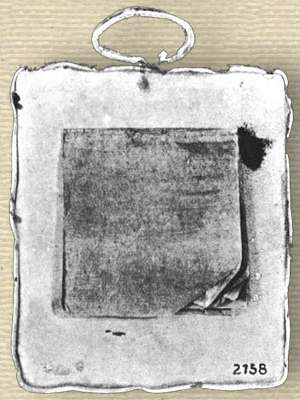
[p.188] Ich habe beim ersten Anblick des achtzehnjährigen kleinen und schmächtigen Junglings nicht glauben können, dass dieser der empfohlene Lehrer sei, aber mich bald von dieser Tüchtigkeit und Brauchbarkeit überzeugt.
In other words, at first sight he could not believe that this small and weakly youth of eighteen could be the teacher recommended, but he soon became convinced of his aptitude and usefulness. After the third half-year at Gottstadt, Georg went to Neuchatel with the object of taking private lessons in [p.189] mathematics and conversational French. It was at this period that, upon the advice of his old friend, Professor Langsdorff, he studied the works of Euler and Lacroix. At Easter, 1811, however, he returned to Erlangen and on October 25 of that year he obtained there the degree of Doctor of Philosophy. His inclination was still towards physics, and his special subjects were now mechanics, light, and particularly colour. For three terms he read mathematics, but for reasons of economy he had again to shoulder what to him was the irksome yoke of a teacher.
He was aware that Professor J. S. Schweigger, of Erlangen, had held an appointment at Bayreuth and had since been [p.190] called to the chair of Mathematics and Physics at Nuremberg. In November, 1811, he accordingly wrote to the authorities at Bayreuth to offer his services, but the result was discouraging. He remained at Erlangen, and on July 28, 1812, addressed a letter to the King of Bavaria praying for employment as a teacher. In consequence, on December 16, 1812, Ohm became a tutor at the Realstudienanstalt at Bamberg. There he remained, impoverished and miserable. From the depths of despair he wrote repeatedly to the King and to the authorities, but from the uncongenial conditions there was no escape.
It must be remembered that the year 1813, critical in the history of Europe, brought Germany to the storm-centre of the struggle against Napoleon. Upon Erlangen’s 8,000 inhabitants, 33,685 troops were in that year billeted. In addition to the threat from without, there was anxiety lest civil war should arise in Bavaria in favour of Prussian rule. Georg was then twenty-four, of military age, but either upon the grounds of philosophy, physical unfitness, or natural reluctance, he stood aside from military service.
In the spring of 1817, he published his first book. He dedicated it to the memory of his father and gave to it the impressive title, Grundlinien zu einer zweckmässigen Behandlung der Geometrie als höheren Bildungsmittels an vorbereitenden Lehranstalten, and he sent a copy to the King of Bavaria, beseeching him to grant amelioration of circumstances. The royal reply was as carefully calculated, but more tactful: there was no appointment vacant, but the book had been placed in the library.
Copies of the Grundlinien were sent to other reigning monarchs, and amongst them, fortunately, to King Friedrich Wilhelm III. of Prussia, who looked with favour upon the application. Ohm therefore left the land of his birth, Bavaria, and in the autumn of 1817 took up his quarters in Cologne as Oberlehrer in Mathematics and Physics at the Royal Konsistorium. There he found friends and apparatus, a library, and, above all, greater freedom, response, and appreciation. The physical apparatus at the Jesuit Gymnasium of Cologne enabled him to proceed with the investigation of the galvanic
[p.191] circuit. He applied himself with complete devotion to his duties, and it is pleasant to record that, in addition to his normal remuneration, he received in October 1822 a “gratifikation” of 100 thalers in recognition of his special services.
His influence and his teaching were now, as in his future career, inspiring. Years afterwards, one of his students wrote:
… seine Art und Weise, sein frisches gesundes Wesen steht mir lebendig vor der Seele, und es gehen selten Wochen, nie Monaten vorüber, ohne dass ich an sie denken muss.
[His nature and manner, his fresh healthy disposition, remain vividly impressed upon my soul; seldom do weeks, and never months go by, but I must think of them.]
His zeal never flagged; he directed his students towards the object which his own genius sought. For a long time his choice alternated between mathematics and physics—mathematics that leads through the mysterious to the wonderful, physics without which mathematics can accomplish little. After the manner of the pioneers, he took care that his mind should not drift. He chose a direct object, and for that, with the utmost skill, he steered. His direct object at Cologne, was the elucidation of the galvanic circuit. He there investigated the relative conductivities of metals, the theory of the galvanometer, and by experiment, the law of flow of electricity in conductors. In April 1826, he realized, however, that if he could break away completely from the restraints of teaching, he could establish the truth concerning electrical circuits. So convinced was he of this that he requested the authorities to grant him leave of absence for a whole year, undisturbed. Leave was accorded in a most gracious and generous manner, and he betook himself to his brother’s house at Berlin. He was probably actuated also by a second motive, for, notwithstanding his happy surroundings at Cologne, he was conscious that his achievements deserved recognition in the form of an appointment to a professorial chair, and on December 15, 1818 —only a year after his arrival in that city—he had written to the Royal Prussian Konsistorium requesting that his case might be kept before them in this respect. If he could now produce something tangible, both objects would be secured. [p.192] The tangible result of his sojourn in Berlin was, in fact, his book, Die galvaniscke Kette, mathematisch bearbeitet, which was published in Berlin in May 1827.
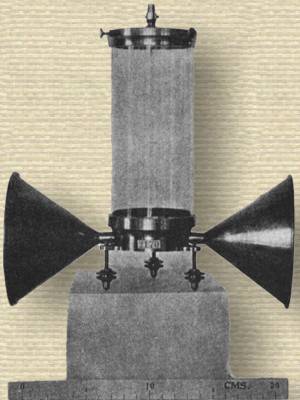
Confirmation of his law of electrical circuits, described in this treatise, came from Fechner of Leipzig, from Pfaff of Erlangen, and from Poggendorff of Berlin. Criticism, however, was levelled against it, gently enough by Kämtz of Halle, but more provokingly by G. F. Pohl in the Jahrbücher fur wissenschaftliche Kritik, to which Ohm forcibly replied. Scientific strife led to the breaking off of friendly relations, and Ohm, taking into account the true nature of the opposition, relinquished his appointment at Cologne and, during the six years 1827-33 retired into private life.
His desire for freedom to continue his investigations, his annoyance at the delay in obtaining an appropriate appointment, his irritation at being attacked where he ought to have been supported, explain his action at this juncture; but behind it all there was a common cause. His philosophy, that of arriving at the truth by observation and measurement, clashed with what was then being taught at Bamberg, Jena, Heidelberg, and Berlin. Germany was suffering from bureaucracy tempered by despotism, impressed upon the wreckage of an empire that had been restrained from advance by feudal forms and various animosities. Hegel had arisen to teach that human life is of more consequence than its incidents, destiny was again to be the rule, details were nothing, specialism was to be discouraged, the national conscience was to arise and unify the scattered states into an imperial organization, rising above the finite to the infinite. Hegel had been concerned in the establishment of the Jahrbücher fur wissenschaftliche Kritik, and in 1827 the popularity of Hegel, expressed in poetry, medals, and gifts of silver mugs, was at its zenith. Hartmann, therefore, discloses the truth when he says:
Die Hegelsche Philosophic beherrschte zu jener Zeit das Feld. Sie wollte die Naturgesetze auf dem bequemen Wege der souveranen Spekulation, nicht auf dem mühevollen Pfade der Messung und Beobachtung ergründen. Das war nun freilich nicht nach Ohms Geschmack; er war aus einem andern Holtz geschnitzt.
[At that time Hegel’s philosophy predominated. It sought to prove the laws of nature, not by the irksome means of testing and observation, but by the convenient method of sovereign speculation. This, of course, was not to Ohm’s taste; he was carved from other wood.]
Apart from these initial skirmishes, Ohm’s law was for some years scarcely noticed, except by a few physicists. In France, between the years 1831 and 1837, Pouillet demonstrated its truth by direct experiment so effectively, and concentrated his mind upon it so intently, that ultimately he almost thought he had discovered it. The triumph of Ohm came in 1841, when the Council of the Royal Society of London awarded him the Copley Medal for his researches into the laws of electric currents, contained in various memoirs in Schweigger’s Journal, Poggendorff’s Annalen, and also in Die galvanische Kette mathematisch bearbeitet. The Council declared that in these works Ohm had established, for the first time, the laws of the electric circuit—a subject then of vast importance, and previously involved in the greatest uncertainty.
Ohm, the Council pointed out, had demonstrated that the usual vague distinctions between intensity and quantity have no foundation, and that all explanations derived from these distinctions are utterly erroneous. Both theoretically and experimentally, Ohm had proved that the action of a circuit is equal to the sum of the electromotive forces divided by the sum of the resistances, and that whatever might be the nature of the current, whether voltaic or thermo-electric, if this quotient be equal, the effect is the same. To Ohm also the Council assigned credit for providing means to determine with accuracy the values of the separate resistances and electromotive forces in a circuit. They drew attention, moreover, to the extent to which the labours of Ohm had been neglected. Within the five years preceding the bestowal of the medal, however, Gauss, Jacobi, PoggendorfE, Henry, and many other eminent philosophers had acknowledged the great value of Ohm’s labours and their obligations to him in conducting their own researches. The special subjects noticed by the Council on this occasion were his researches on the conductivity of metals, on the power [p.193] of electromagnetic multipliers (galvanometers), and on the nature of unipolar conductors and hydro-electric currents.
In England, those physicists who had most experience in electrical researches bore the strongest testimony to the help they had derived from Ohm’s results. It was confessed that if the works of Ohm had been earlier studied, the industry of experimenters would have been better rewarded.
The comment of Eugene Lommel upon this acknowledgement of Ohm’s results was:
So wurde Ohm vom Auslande her die späte Anerkennung zu Theil, die ihm das Vaterland so lange vorenthalten hatte.
[Thus foreign countries accorded to Ohm the recognition the Fatherland had so long withheld.]
Lommel proceeds to state that after the publication of the work on the galvanic circuit, Ohm’s attention was directed to molecular physics.
The eulogy bestowed by the Royal Society upon his discoveries, encouraged him to investigate, by the aid of analytical mechanics, the form, magnitude, and mode of operation of atoms. He wished, in fact, to produce a Principia for the micro-cosmos. Fate, however, stood between this desire and its realization. The dismal years 1827-33 were given by him to mathematical instruction at the Military School at Berlin. He tried unsuccessfully to obtain a better appointment there or at Oldenburg; for the remuneration was less than half what he had received at Cologne. Happily, on July 3, 1833, King Ludwig I. of Bavaria, issued a decree that relieved Ohm of these anxieties. He was given a professorship at the Polytechnic School of Nuremberg, and he retained touch with that institution until 1849. In 1835 he was appointed also to the Chair of Higher Mathematics at the University of Erlangen, and at the same time State Inspector of Scientific Education. Ultimately, he became Rektor at Nuremberg. Towards the end of 1849, he was appointed by Maximilian II., Professor of Physics to the University at Munich; the Akademie of Science selected him as Conservator in Mathematical Physics, and in addition, following Steinheil, he was adviser concerning the development of [p.194] telegraphy for the State. These manifold duties prevented him from continuing his researches in molecular physics. His biographers have found some compensation for this loss in the circumstance that in 1852 and 1853 he published at Munich his results, obtained in the summer of 1851, on interference phenomena and polarized light, and that he discovered how to express his conclusion in a simple formula. Unfortunately, these results, in which two plates of crystal in polarized light could be made to produce a series of concentric coloured ellipses, resembled in many respects those arrived at, quite independently, by Langberg of Christiania, and published in the Norwegian Magazin for Naturvidenskaberne for 1841.
Notwithstanding his disinclination for teaching, circumstances to the end obliged Ohm to teach, and he taught well. He was an advocate for individual instruction. The usual two-hour “lecture” was broken up by him; about half was at the blackboard, and the remainder was given to working out examples with his students. In this manner he remained in touch with his class. Throughout Germany, his method left its effect. The conditions, however, under which he taught were opposed to rapid progress. For example, students had forms to sit upon, but no desks at which to write. Their mathematical knowledge at entry was so slight that physics to them was at first unintelligible. He realized this, and in 1852 he devoted his precious time to writing out for them with his own hand complete notes, which were lithographed.
Ohm lived simply. He was of marked energy, of middle height, compactly built, sturdy and strong. He was clean shaven, and his friend Mann says that his physiognomy was of the Martin Luther type. His eyes were large and penetrating; his mouth revealed wit, satire, and good humour. The long dark-blue coat he wore was provided with side-pockets which always held a snuff-box. In diction and phrase he excelled; moreover, his voice was full, and far into his life it retained its attractive quality. If a problem was to be solved, he approached it with his students as though he did not yet know what it would reveal. He encouraged them to find the answer, and at last he would ask: Do you understand? Is it clear? After he had [p.196] explained it, it was always clear, crystal clear. Bauernfeind has recorded that Ohm was by nature benevolent. The bitterness of his early rebuff did not rankle. He spoke but little, but what he said was of substance. Beyond the College gates, he was known within his own country but slightly. His scientific writings were brought together and published at Leipzig in 1892—under the editorship of Dr. Eugene Lommel, Professor of Physics at the University of Munich— with the title Gesammelte Anhandlungen von G. S. Ohm. It is a book of 855 pages, relating to 23 communications in which can be seen the results of researches extending over thirty years. The subjects dealt with are comparatively few, but the treatment is thorough, and there is evidence line upon line of tenacity of purpose. From the first, there is manifest the determination of Ohm to establish the law of flow of electricity in metallic conductors. This led him naturally to consider the development of such measuring instruments as the multiplier, or galvanometer, which Poggendorff and Schweigger had devised in 1821. It attracted him also to the results obtained by the English physicists, Children and Davy, with regard to the glow of wires heated by electric currents. Ohm further investigated the question whether the law established for metallic conductors was applicable to liquid conductors. In addition, time was occupied in elucidating the experiments of Erman on so-called “unipolar conductors”. Then followed his work in acoustics, particularly with reference to combination tones, and lastly his experiments and theory relating to polarized light.
From these contributions of Ohm to natural science may be singled out three of transcendent value: his law of electric flow, his law of combination tones, his philosophy of research in physics. The law of electric flow is based upon experimental results appertaining to a property of matter. It implies that the potential difference between any two fixed points on a given homogeneous conductor, when the flow of electricity between those points is steady, is a direct measure of the current in the conductor, between those points. The ratio of that potential difference to that current, in these circumstances, is a characteristic of the portion of the conductor in question, and is [p,197] called the “resistance”. So long as Ohm’s law applies, “resistance” thus defined is constant for all values of the potential difference between the two points. In his own words:
Die Grosse des Stromes in einer galvanischen Kette ist der Summe aller Spannungen direkt, und der ganzen reducirten Länge der Kette umgekehrt proportional, wobei man sich erinnern muss, dass jetzt unter reducirter Länge die Summe aller Quotienten verstanden wird, die aus den zu homogenen Theilen gehörigen wirklichen Langen und dem Produkte der entsprechenden Leitungsvermögen und Querschnitte gebildet werden.
[The magnitude of the current in a galvanic circuit is directly proportional to the sum of all the electromotive forces, and inversely proportional to the whole of the reduced length of the circuit, and it must be remembered that by reduced length is to be understood the sum of all the quotients which can be formed corresponding to all the actual lengths of the homogeneous parts and the products of the corresponding conductivities and cross-sections.]
The law is most easily demonstrated to hold in the case of homogeneous metallic conductors at constant temperature.
Ohm’s law thus defined is applicable to all conducting systems and is free from ambiguity; its usefulness has carried it into the wider field of electrical research and engineering, where its interpretation has occasionally been stretched to the very limits of its validity. From metallic conductors it has been extended to electrolytes, from electrolytes to dielectrics, from dielectrics to electric arcs, and from arcs to thermionic valves. Moreover, by mathematical devices, inductance, capacity, and leakance have all been operated upon to convert them into terms capable of being interpreted as “resistance”, so as to bring them under the jurisdiction of a kind of Ohm’s law. A clash consequent upon this struggle for latitude occurred in England in the summer of 1896, when there was a fierce and prolonged debate with regard to the existence, or not, of “negative resistance” in the electric arc. The attack was led by Dr. S. P. Thompson, at a meeting of the Physical Society of London, and was hotly responded to by Professor W. E. Ayrton, in a characteristic speech beginning with the words “It is a pity that so much erudition should be marred by three obvious misconceptions. …” After some weeks of acid controversy, it [p.198] was decided to refer the matter for settlement to Oliver Heaviside who gave judgment as follows:
I am asked my opinion about negative resistance. This I take to mean simply that if a body formally obeyed Ohm’s law, E = RC, and Joule’s law, H = RC2t, but with R a negative instead of a positive quantity, it would possess negative resistance. The effects produced by the negativity of R (and other quantities) have occupied my attention in certain papers, and are interesting and instructive. But I have no faith whatever in the permanent existence of a body with negative resistance, on account of the general instability. At the same time I am not prepared to deny that a substance might temporarily, and under suitable circumstances, behave as a negative resistance approximately, especially if it is in a state of continuous material change. … Whether the arc may be conveniently regarded in this light, is not for me to say. I do not know enough about the arc. I prefer gas for personal use.—Oliver Heaviside, July 28, 1896.
Pioneer work in electrical communication, from the middle to the end of the nineteenth century, was in great measure carried on by electricians whose equipment of theory was limited to applications of Ohm’s law in the somewhat ambiguous form
Current = C = E / R = (Electromotive force of battery) / (Resistance)
When they dealt with single metallic conductors, there was not much difficulty. The application of the formula to networks, and to circuits containing electrolytes, especially if so-called “back electromotive forces” happened to be present, was sometimes troublesome to them. The meaning of the difference of potential between two points was clear, because most of the electricians of that time were familiar with static electricity, and with some form of electrometer. They had, however, to grasp the fact that in applying Ohm’s law they were concerned not merely with the electromotive force of their battery, but with electrolytic and other effects, usually involving a counter electromotive force E1 so that the current was given by
C = (E – E1) / R,
Where R was known or could easily be measured. With the improvement of galvanometers, there followed the ammeter and the voltmeter. Electricians began to think less in terms of resistances, and more in terms of current and fall of potential along conductors. At the next stage of the advance, attention was directed to concise definitions of electrical power and electrical energy. Ohm’s law remained the basis, and carried its way at last into the new field of alternating current theory. This had been forbidden ground, for Ohm’s law predicated the steady state, and here all that was constant was inconstancy. Nevertheless, a variety of Ohm’s law at last sprang into existence for alternating currents, and it flourished exceedingly. Thus Ohm’s law was—as Ohm had prophesied in Schweigger’s Journal of 1826, it would be—in perfect agreement with experiments in all directions, and characterized by simplicity that extends its application to all experience with electric currents— simplicity such as is only found in truth. Or in his own words:
… wie nur in Gefolge der Wahrheit zu erblicken ist, als das reine Gesetz der Natur verkündigt.
[Revealed only in the quest of Truth, as manifested in the pure law of Nature.]
He started from the fact that when two dissimilar metals, or certain other substances, touch one another, they maintain at the point of contact a difference of potential. He recognized that chemical changes in fluid portions of a circuit introduce complexities that occasionally lead to apparent exceptions. These, until interpreted, amount almost to contradictions. He therefore deferred consideration of the parts of circuits that are subject to chemical change, and he dealt first with a circuit of homogeneous material of the same cross-section throughout. For such a circuit he found by experiment that the slope representing potential, co-ordinated against electrical resistance, is a straight line. This line he plotted, and he proceeded in like manner to obtain zig-zag representations of the fall of potential for composite circuits built up of conductors of various lengths, sections, and materials. Then he showed how to calculate the fall between any two given points along such a composite [p.200] circuit. He demonstrated that for the steady state, or, in his words, for a circuit—“deren Zustand bleibend ist”—the current is of equal strength at all points along the conducting system, and that a change of current at any one point corresponds to similar change of current throughout. He stated his law, in terms not of “resistance” but of “reduced length”. By “reduced length” he meant the length of a wire—of given material, such as standard copper, and of given sectional area— having a resistance equal to the sum of the resistances of the circuit in question.
He pointed out that this law differed essentially from those of Davy, of Becquerel, of Barlow, and of his own early investigations; the discrepancies in those tentative formulae he attributed to the smallness of the range available in the interpolations by which they had been obtained. His argument was next directed to proving that interchange of the parts of a composite line of conductors has no effect upon the total resistance. He proved that for all points along the conductor, provided that the ratio of potential difference to resistance is constant, the current is constant. The trouble in his experiments arose because the resistance of his battery was large and unsteady. He explained why results of greater consistency were obtained with a thermocouple, where the resistance is small. Then he dealt with problems relating to cells in series and in parallel, the effect of putting a galvanometer into the circuit, and general expressions for the resistance of conductors in parallel. He studied also what happens when a conducting body of considerable size is brought up to a circuit, and he showed that the effect is independent of the material of the added body provided that it is a conductor. He completed the task by mathematical investigation of the current in a circuit when the atmosphere exerts some effect (i) without chemical changes, and (ii) with chemical changes. In this part of his work he led the way to the problem of leakage of transmission lines, and its solution by hyperbolic functions in exponential form.
To convert what at first was an empirical rule, into a physical law of the highest order, it was necessary for Ohm to give it the support of theory. He proceeded to develop a theory of [p.201] electric flow, following the results of Laplace, of Poisson, and chiefly of Fourier, with regard to the diffusion of heat. During the years 1807-16, Joseph Fourier had communicated several important contributions upon diffusion to the Institut de France. In 1822 there was published his Theorie analytique de la chaleur—which Heaviside in 1895 described as the most entertaining mathematical work ever seen. Its appearance was well timed to influence Ohm. Fourier began with the observation that different bodies possess in different degrees the power (i) To contain heat; (ii) To conduct heat through their substance; (iii) To receive or to transmit heat through their surfaces. Corresponding thereto he defined (a) The capacity (la capacité de chaleur); (b) Specific conductivity (la conducibilité propre); (c) Emission conductivity (la conducibilité extérieure).
Fourier had found that when a metal bar is exposed at one end to the constant action of a source of heat, and every point of the bar has attained its highest temperature, the system of fixed temperatures is distributed along the bar in accordance with a logarithmic law. His next step was a statement to the effect that the slope of any curve at a given point measures in geometry the tangent, in dynamics the velocity, in heat the quantity that flows at each point of a body across a given surface, in a small unit of time. He further laid it down that the quantity of heat that one molecule receives from another in a given time is proportional to the difference of temperature of the two molecules, and he derived, for the temperature at any given point along the bar, an equation of the exponential form that in recent years has become familiar in the corresponding problem of electrical transmission, where attenuation is taken into account.
Ohm assumed that the three constants and the mode of handling the differential equations that had been used by Fourier and by Poisson in the heat problem would be directly applicable to electrical conduction. He therefore introduced corresponding coefficients, and he wrote down the differential equation connecting the rate of change of potential with time at any point along an electrical conductor, in terms of the potential itself and of the second differential of potential in respect to [p.202] distance. The current was next expressed as the rate of change of potential with distance, multiplied by a coefficient; and he showed that since there can be no heaping up of electricity at a point, such an expression with appropriate coefficients can be applied to composite conductors, or to branched circuits. Further, a branch might be a liquid, provided that there is a good contact at the surface of separation. His first differential equation was subsequently made to represent the steady state by omitting the time term; the integration was thus simplified, and he obtained an expression for the potential at any given point along the conductor—the law of electrical diffusion, where the diffusion occupies the entire conductor. He considered also what happens when such a conductor is left to itself, and further the effect of bringing into contact with it, at a given point, a mass of metal or other conducting substance.
Maxwell (Art. 333, Electricity and Magnetism) paid full tribute to the excellence of this work of Ohm, but he held that Ohm, misled by the analogy between electricity and heat, entertained the erroneous opinion that a body when raised to a high potential becomes electrified throughout its substance, as if electricity were compressed into it. Maxwell pointed out that although this opinion itself was wrong, it led Ohm to employ the Fourier equations to express the true laws of conduction of electricity through a long wire. In these circumstances it is desirable here to record the original statement of Ohm (p. 145, Gesammelte Abhandlungen):
Es ist nämlich durch theoretische Betrachtungen sowohl als auch durch Versuche, welche an dem elektrischen Strome angestellt worden sind, keinem Zweifel mehr unterworfen, dass die bewegte Elektricität in das Innere der Korper dringt, und ihre Menge sich deshalb nach dem korperlichen Raume richtet, wahrend es auf der anderen Seite ebenso ausgemacht ist, dass die ruhende Elektricität an der Oberfläche der Korper sich sammelt und ihre Menge deswegen von der Flächengrosse abhangig ist.
[From theoretical considerations and by experiments with electric currents, there is left no further doubt that electricity in motion penetrates the interior of bodies, and that consequently the quantity depends upon the volume of the bodies. On the other hand, it is found that the static electricity on the surface of the bodies [p.203] accumulates and that its quantity on this account depends upon the extent of the surface].
It must be remembered that Ohm’s task was to bridge the gulf between static charge and the steady state of electric flow. He had to contend with the fact that whereas a static charge resides only on the surface of a conductor, electricity in motion through a wire, for the steady state, utilizes not merely the surface but the whole cross-section and substance of the wire. Was he then in error in the manner suggested by Maxwell? The essential distinction that Maxwell wished to emphasize was no doubt that to which he directs attention in Art. 244 of Electricity and Magnetism. In the electrical case, however powerfully a closed conductor may be charged, there are no signs of electrification within it; and an insulated body within it will, when taken out, exhibit no electrical effects. In the thermal case, if such a conductor is raised to a high temperature, the body within it will, after a considerable time, rise to about the same temperature as the conductor itself, and when it is taken out it will be hot. Conducting bodies can absorb and emit heat, but they can neither absorb nor emit electricity. Hence, in electrical phenomena there is complete absence of anything to correspond to capacity for heat, or in Maxwell’s words:
It is impossible to give a bodily charge of electricity to any substance by forcing an additional quantity of electricity into it.
If Ohm had lived to reply to Maxwell he would have responded—”I never said you could.” He should be credited with having used the analogue to Fourier’s capacité de chaleur with mental reservations.
Heaviside, who otherwise appreciated the work of Ohm, re-echoed the complaint that the assumption that a wire possesses the power of storing up electricity in its substance, like heat, is erroneous. In partial vindication of Ohm, however, he added:
Why he should have come to the right result by wrong method was simply that, whether electricity is stored up in the substance [p.204] of a wire, or goes to the surface and stays there, the equations are of exactly the same form.
In the interpretation of Ohm’s law by analogies, Heaviside also warned electricians against supposing that electromotive force has to “overcome” resistance, as though resistance were a force of friction. In the sense in which resistance is spoken of in association with Ohm’s law, the mechanical analogue of resistance is more closely that of a coefficient of velocity in the case of a body, on a level surface, sliding steadily under the action of a constant force. The constant force (electromotive force) is represented by the product of the velocity (current) and the coefficient (resistance), there being in this analogy no lifting of the load.
Contemplation of the physical contrasts that manifest themselves in the study of the way in which Ohm’s law is established—the distinctions between heat and electricity, mechanical friction and electrical resistance, the residence of static charges of electricity at surfaces and the fact that electrical resistance to steady currents is a function of the whole cross-section, added to the part played by magnetic forces, and the mystery in all these circumstances of how an electric current heats a conductor—thus reveals to us how wide are the gaps yet to be filled between the conventional framework of hypothesis that serves so well as a base for calculation within the present range of electrical knowledge and the real machinery and scheme of operation of conductance.
The work of Ohm upon so-called “unipolar” substances deserves attention. It relates to experiments by Jäger, Becquerel, Fechner, Erman, and others, with metallic plates and condensers, particularly with regard to the effect of earth connections and residual charges, and to a group of partial conductors, containing disturbing electromotive forces. It was concerning such results that Biot said that in no branch of physics were there so many differences of opinion and uncertainties as those relating to galvanismus, and that there was (1831) scarcely a physicist whose views did not differ from those of every other upon important principles. Becquerel, Davy, Walker, Ritter, Berzelius, de la Rive, and Nobili, were [p.205] all conspicuous in this heterodoxy. Ohm saw that much of the trouble arose from defective instruments. He realized that the galvanometer as then constructed did not answer the “Wo und Wie” as he called it. Thereupon he directed attention to the merits of the electrometer that deals with only single points of a circuit, and he advocated the simultaneous use of both instruments, particularly in circuits containing metals and liquids.
Attention became more or less focussed upon an experiment by Erman. He claimed to have discovered a class of imperfect conductors capable of transmitting more easily one of the electricities than the other. For example, into a piece of soap, alkaline and very dry, he introduced two metallic wires each communicating, respectively, with the poles of a battery. The two poles retained their potentials. But, on touching the soap with a conducting body, the negative pole became discharged, and the positive pole acquired the potential it possessed when the soap was removed and the negative pole was put to earth. He found the same result with the dried white of an egg, with the flame of phosphorus, the flame of alcohol, and with other flames, except that it was the positive pole that became discharged in flames. For this reason he introduced the terms “unipolar-negative” and “unipolar-positive”.
Ohm interpreted the results as a property not of the substance interposed between the poles, but of the current that traverses the substance, i.e. as an electrolytic effect. The soap, in his opinion, was decomposed into an acid and into an alkali. The acid he thought to be of an insulating character, and the acid, he supposed, enveloped the positive wire, preventing the positive charge from passing to earth.
The literature of this and allied subjects throughout Europe, for various reasons, covers an extended period. Ohm’s book Die galvanische Kette was translated into English in 1841, and into Italian in 1847; Pouillet supplied a translation of part of it in 1837, but it was not available in complete form in French until 1860, when J. M. Gaugain produced an edition with appreciative critical notes. By 1860 it was widely known that Ohm had discovered what was generally called the law of [p.206] length, section, and derived circuits, but it was not then generally recognized that this law was associated with a theory that embraced innumerable questions relating to the propagation of electricity.
In 1838 Faraday (Experimental Researches, vol. 1, No. 1635) discussed unipolar bodies. He remarked:
If a unipolar body could exist, i.e. one that could conduct the one electricity and not the other, what very new characters we should have a right to expect in the currents of single electricities passing through them, and how greatly they ought to differ, not only from the common current which is supposed to have both electricities travelling in opposite directions in equal amounts at the same time, but from each other! The facts which are excellent, have, however, gradually been more correctly explained by Becquerel, Andrews, and others, and I understand that Professor Ohm has perfected the work in his close examination of all the phenomena; and after showing that similar phenomena can take place with good conductors, proves that with soap, etc., many of the effects are the mere consequences of the bodies evolved by electrolytic action.
Ohm’s researches on this question had appeared in Schweigger’s Jahrbuch der Chimie, vol. viii., 1830, and it is in relation to this that Faraday added:
Not understanding German, it is with extreme regret I confess I have not access, and cannot do justice, to the many most valuable papers in experimental electricity published in that language.
Ohm’s contributions to acoustics appeared in Poggendorff’s Annalen in the years 1839-43. His researches led to the establishment of his law governing combination tones—by which the human ear proceeds in its analysis.
He showed that the ear can derive the sensation of tone only from that particular motion of the air in which the particles oscillate like a pendulum. Helmholtz summarized the results by stating that every motion of the air that corresponds to a composite assemblage of musical tones is, according to Ohm’s acoustic law, capable of being analysed into a sum of simple pendular vibrations, and to each such single simple vibration [p.207] corresponds a simple tone, sensible to the-ear, and having a pitch determined by the periodic time of the corresponding motion of the air. This law rescued acoustics from confusion. Its effect in the development of innumerable applications of physical science is everywhere to be observed. Yet it remained in comparative oblivion for eight years after the death of Ohm, i.e. until Helmholtz in Die Lehre von den Tonempfindungen used it to explain the relation of overtones to music. This achievement of Ohm is enhanced by the fact that he possessed no ear for music. Urged by a strong desire to solve the riddle of musical tone, he enlisted the services of a musical friend to supply an ear, and he found this friend in Dr. Kellermann.
Ohm’s work was based upon the principle that the truth of what is demonstrated by experiment cannot be denied, that what is based upon hypothesis must only be accepted in so far as it is confirmed by observation, that until theory can be exhibited as precise calculations it is imperfect and does not inspire confidence, and that such calculations are the touchstone of hypothesis. His precept was that where these tests are lacking it is best to defer judgment until better data are available. He studied especially conductivity because he imagined that it would lead to knowledge of the internal structure of matter. Bauernfeind states that Ohm’s view was that the attractions and repulsions of magnets should be explained not by supposing the existence of positive and negative magnetism, but by imagining in the atoms (Körperatome) the existence of constant positive and negative currents.
At 10 p.m. on July 6, 1854, on which day, notwithstanding his bodily weakness, he had delivered his lecture, Ohm died. On the following Sunday he was buried at Munich. The grave is in the Sudliche Friedhof which can be reached from the city by way of Sundlingertor Platz and Thalkirchner Strasse. It is near the edge of a path that skirts the front of a building known as the Akadien, within the cemetery. Following that path, the grave is about twenty-three paces from the eastern extremity of the building. It is overgrown with ivy, but the simple stone stands clear, and is inscribed: [p.208]
in München
Geb. 16 Marz 1787
Gest. 7 Juli 1854
Georg Simon Ohm
Regius Professor
at the University
of Munich
Born 16th March, 1787
Died 7th July, 1854.]
It is unfortunate that a philosopher who devoted his life to precision should have inaccuracy stamped upon what is alleged to be his house, and an erroneous date engraved upon his tombstone. He was born not in 1787 but in 1789.
In 1881, the Electrical Congress at Paris adopted the name of Ohm for the practical unit of electrical resistance, 1 Ohm = 109 C.G.S. units. The standard Ohm is now determined with an accuracy of about 1 part in 100,000.
As an example of his handwriting, the letter (Fig. 9) reproduced from Ludwig Hartmann’s book may be examined. It relates to a request made to Ohm by Thiersch for an obituary notice of Gay-Lussac, who died on May 9, 1850.
TRANSLATION.
To Councillor Von Thiersch—
My head was in a whirl and is still not quite clear, although it feels much better. I must avoid all continuous occupation, and for this reason I shall not be able to attend the next public conference.
Under these conditions, the information you requested, relating to the merits of Gay-Lussac would be difficult for me to give—this would cause me distress if I were not certain that you could obtain what is required, rapidly and surely through Councillor Vogel.
Gay-Lussac was more of a chemist than a physicist, and all his purely physical work was merely a forerunner of the chemical, to which it always remained most closely related. A chemist will therefore be in a position to fulfil your request completely.
Yours,
G. S. Ohm.
Munich, 25th November, 1850.
- Science Quotes by Georg Simon Ohm.
- 16 Mar - short biography, births, deaths and events on date of Ohm's birth.
- Georg Simon Ohm - Short biography from John Munro, Pioneers of Electricity; Or, Short Lives of the Great Electricians (1890).
